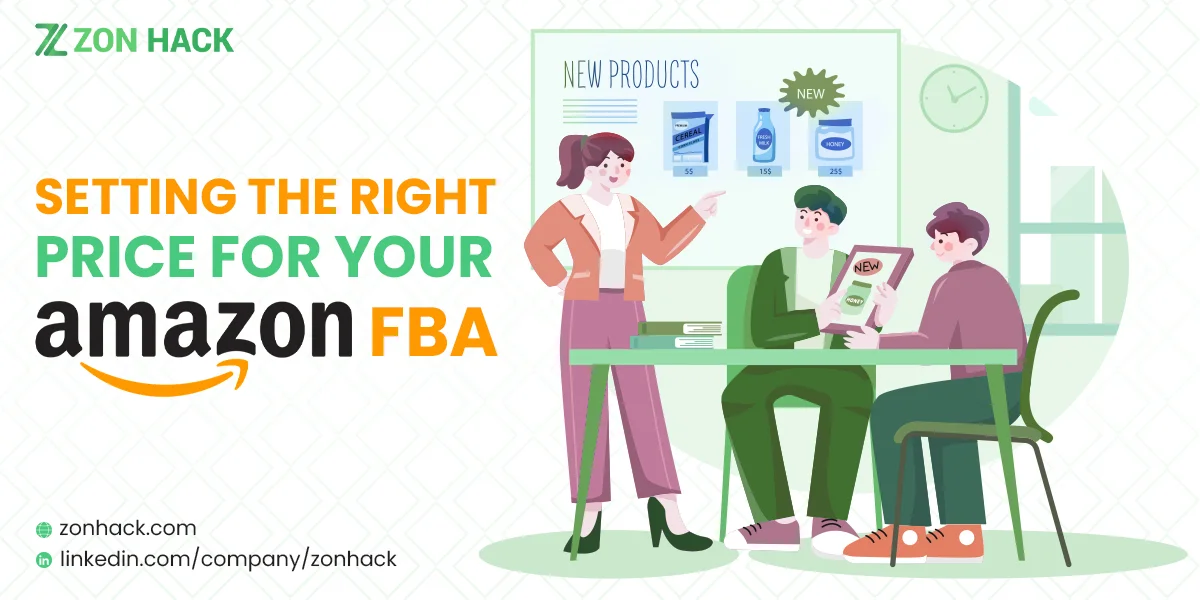A significant step to optimize your listings on Amazon, whether as a new or experienced seller, is product pricing. After finding the best product to put up for sale on Amazon, it is essential to have a strong pricing strategy. It is impossible to exaggerate the importance of a pricing strategy. Even before the popularity of internet retailing, customers have been characterized to use price as a determinant while choosing products. And, undoubtedly, presently, pricing is a major stronghold ensuring Amazon’s continued success.
Zonhack is extensively experienced in helping companies, whether small, medium, or large-sized, to set the best prices for their products on Amazon. This article focuses on how you, as a seller, can set the right price for your Amazon FBA product, maximizing sales and, ultimately, profit.
Of course, you need to consider several factors when setting a price(s) for your products(s), including your buying or manufacturing cost, the degree of product competition, how these competitors price their products and your present sales rank. Without any further ado, let us get right into helping you set the right price for your product on Amazon!
How to Set the Best Product Price on Amazon
Below are the best seven (7) techniques to get started:
1. Put your fees and costs under paramount consideration
Two major factors influence your ability to calculate your product’s selling price: the profit margin and your costs. While the profit margins are somewhat straightforward, costs might be the opposite. Nonetheless, before you can decide your product’s final price, whether direct or not, you cannot eliminate the effect of the incurred costs. This ranges from manufacturing costs to inventory costs, marketing, shipping, and even sales (retail) costs.
And of course, Amazon features a few marketplace fees, which vary depending on the product – from 8% for electronics and up to 20% for jewelry. Hence, you must conduct proper and detailed research before you list your product for sales.
Cost calculation isn’t a “one-off” task. Some of these costs considerably vary over time, such as shipping and packaging costs. So, you need to adjust your product’s price accordingly. Ensure you also consider fixed costs, such as office spaces, payroll, utilities, etc. While some of these may appear basic, they should be significant determiners of your product’s price. Otherwise, you may be risking a loss from the sales of such a product.
2. Price your product according to your brand
Generally, you need to first identify either as a premium brand or a low-cost leader – branding is highly essential when looking to sell a product. What type of brand are you?
Low-cost leaders often put forward straightforward products for sales, which largely relies on changeable processes and other products’ knowledge. As a low-cost leader, ensure you aren’t underpricing your products. You can implement the “.99” rule as a solution. That is, ending your products’ prices in .99 rather than a round figure. This makes products look seemingly low-cost without painting such a product as underpriced in the face of potential buyers. Remember, underpricing is as bad as overpricing – this depends on the product type, though. Sometimes, some persons interpret underpriced products as cheaply made and below-quality products. You need to identify the margin involved as a low-cost leader.
Albeit, selling premium products demands you to convey the quality sense. While this may translate to choosing consistent and relatively higher prices, you can also have a minimum advertised price policy, which will help you to maintain a particular pricing threshold and ultimately protect the image of your brand.
You must have a deep and detailed understanding of your brand and your customers before you can make these price considerations. Without knowing your customers’ behaviors, how such customers see your brand, how competing products are priced, you may never make the right price decisions for your product.
3. Incorporate flexibility when choosing a suitable product price
More often than not, most sellers eventually set unrealistic prices for their Amazon products. Setting such prices isn’t an issue, actually. Instead, failing to keep your pricing strategy flexible is the actual problem. Flexibility is essential, particularly because of the changing nature of the market.
Unless you’re selling a premium product, it is unwise to advertise a set price because the likelihood of such a price change is exceptionally high. However, inarguably, adjusting your prices to suit a market change may be somewhat challenging. Hence, the need to consider auto pricing.
Auto pricing on Amazon leaves room for price changes as it responds to other sellers’ changes of similar products. Auto pricing is an excellent option for sellers selling highly competitive products.
4. Redirects your customers to your Website
In the actual sense, nobody likes to make money “for” Amazon. Therefore, most sellers are ultimately looking to actually buy from their websites instead of Amazon’s. This way, such sellers can efficiently evade all Amazon fees plus the extra effort invested in managing eCommerce marketplaces, which ultimately makes them set even lower prices yet still making larger profits.
An effective way of encouraging customers to visit your eCommerce website is to set the prices on your Website slightly lower than those on Amazon. This might, however, turn out ineffective if you are in a highly competitive and saturated market.
Another strategy is to establish a customer-seller relationship off Amazon. For instance, you can mail your customers, thanking them for their patronage, pitching your Website to them, letting them see reasons to buy from your Website other than on Amazon. You may introduce incentives, promotional offers, etc.
Besides, you can include an insert to your product’s prepackaging. This way, you can “lure” them to visit your Website. It is also a great avenue to offer a coupon or promotion. Some Amazon sellers also sometimes sell select products on Amazon while making its variations or accessories available exclusively on their Website.
Additionally, as an Amazon FBA (Fulfilment by Amazon) seller, you can use this strategy to reduce the individual SKUs stored by the Amazon warehouse for you.
In essence, focus on using Amazon to promote your brand, encouraging customers to purchase from the inexhaustive products list on your Website!
5. Use the $10 rule
The $10 rule is most effective for Amazon sellers using Amazon FBA. The law typically changes whenever your products fall below or above $10.
If your product is below $10, it may be somewhat tricky to make profits while still ensuring such a product’s affordability, mainly because of Amazon fees. This explains why prices with lower prices often have lesser margins because of these fixed fulfillment fees. For instance, products that you sell on your Website for $6 may need to increase up to about $12-$13 to make a profit. The same doesn’t apply to products priced above $10. Inasmuch as such products have decent profit percentages, it is typically easy to contain all Amazon fees and still make a reasonable profit.
However, this doesn’t mean sellers of lower-priced products should fret. Instead, there are a few other innovative ways of turning the situation in your favor. For instance, you can consider multi-packing to migrate into the over-$10 territory.
6. Explore your experience and intelligence
Amidst finding the best price for your Amazon FBA product, do not eliminate the need to explore your experience and intelligence for the implementation of these pricing strategies. Of course, it is one thing to know these tips, while it is an entirely different thing to understand how to implement them. Their implementations include:
- Making future decisions from past information
- Anticipating the trends of other competitors
- Knowing when to incorporate repricing and when to upsell bundle or any other thing to move a product.
- Identifying products that need to be sold quickly and those that need a slight boost for sales at higher prices.
7. Never forget customer reviews.
Despite abiding by all the tips to set the right price for your Amazon FBA product outlined in this article, if you fail to register excellent seller and product feedback on Amazon, you will be making next-to-zero or zero sales.
Let’s make this personal: imagine yourself finding a product on Amazon. While trying to make choices, do you prioritize your attention to products with just two-star ratings? Do you consider sellers with relatively poor (lesser than 90%) feedback? Of course, not!
Ensure you get your customers to leave great reviews after purchasing your product on Amazon. I have detailly analyzed the best ways to get genuine feedback and reviews as an Amazon FBA seller in the next section.
Getting Real Product Reviews on Amazon
As mentioned above, it is (almost) impossible to sell any product or item on Amazon without having product reviews. Technically, the quality and amount of feedback your product has is consequential to your conversion rate increase. Unfortunately, most customers do not write reviews after buying from Amazon. It is a common worrisome trait. Nonetheless, Zonhack has curated a list of effective ways to increasing real reviews of your product on Amazon.
Below are three expert-proven ways of getting real product reviews on Amazon:
1. Directly ask your customers for reviews via Email
Asking your customers to leave a review on the product they’ve just purchased is an age-long effective means of getting such a customer to actually leave a review after buying. However, you need to ensure you aren’t forcing them to do so or compelling them to leave a “positive” review for your products. If Amazon finds our (perhaps such a customer reports), you may be inviting trouble for yourself.
Instead, you can:
- Send the customer an email some days after purchasing.
- Neutrally ask such customers to leave a review. Once again, do not force your customers to positively review your product.
- Some customers haven’t written product reviews before. You can send the direct URL to your review page to such customers.
You can also exploit the avenue to ensure the correct delivery of the product while allowing the customer to narrate their experience with your product. Creating a smooth relationship between you and your customers is essential to build continued patronage and brand loyalty.
2. Reply your reviews
Amazon’s product page, including comment sections and reviews, is public; everyone can access and see the detail therein, including potential future customers. Hence, you can seize such an opportunity to stand out!
Ensure you reply to all your reviews, especially the negative ones, or reviews wherein your customer asks a question. Commenting on these reviews is a subtle means of building trust and reliability in future customers, which ultimately leads to conversion.
Undoubtedly, customers often enjoy the “king” treatment. A customer might decide to change their negative comment to a positive one whenever their seller responds to such a comment. Perhaps because they are elated, such a seller cares about their issue/experience.
3. Ask customers who send you reviews via Email
Like I mentioned earlier, some customers aren’t actually familiar with navigating the Amazon Marketplace interface. Hence, they may choose to tell you how much they enjoyed the product they bought from you via your contact address, whether Email, social media, over the phone and others.
It is very advisable to ask these customers to leave their reviews too on Amazon! However, you need to be quite careful to not sound “pushy” or too demanding. Instead, ask politely. Try to find out if they want to share their experience publicly or they are only comfortable with the private feedback. Once again, do not force it.
WARNING
Amazon has strict rules mitigating against fake reviews. Consequently, ensure:
- You avoid giving free products to customers for Amazon reviews.
- You avoid excessive giveaways and review clubs that don’t comply with Amazon’s TOS.
Doing any of these may result in severe issues for you, including the suspension of your seller account. Instead, focus on building trust and loyalty with your customers, ultimately causing you to make more sales as an Amazon FBA seller!
Final Thoughts
Realistically, there is no perfect pricing strategy. All strategies, including those discussed in this article, are relative, depending on the seller and also the situation such a seller is in. Hence, you need to find the best pricing strategy to help you set the right price for your Amazon FBA product. Nonetheless, the tips and strategies outlined in this article will assist you in getting the best profits from your products as an Amazon FBA seller. Should you need professional intervention, do not hesitate to contact the experts at Zonhack. They are always available to listen to you!




